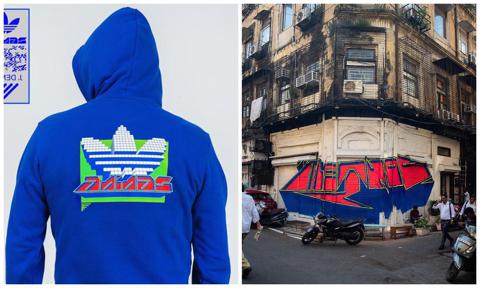
His so-called ‘neo-futurist’ art leaves onlookers mesmerised and often puzzled over what they could mean, with his insistence on remaining anonymous adding further mystique to his work. From murals in the 90s, paintings in the 2000s and now sculptures, world-renowned Spanish artist J Demsky paved the way for a new form of art in his 30-year career. After painting his way around the world — he has murals in over 20 countries — exhibitions in several countries, and collaborations with brands like Comme des Garçons, Ballantine’s, Nike and Adidas, he recently showcased his work at Method Gallery in Mumbai.
‘Interdimensional Hypnosees’, the showcase, was a one-of-a-kind exhibit of sculptures that made one believe that the present and future can exist in parallel dimensions. Could this mean that travel between the two could go unnoticed? Could a sliver of the future be brought back in time? Demsky makes one think…
HELLO!: You’re described as a neo-futurist artist. Could you explain this in your own words?
J Demsky: “Neo-futurism is about reimagining the way things are. As an artist, I don’t believe in a set definition of time — the future is new, and the future is here. This is how I approach art.”
H!: How’d you define your style of art? What are you experimenting with today?
JD: “As a kid, I spent time playing arcade games, watching Japanese mecha and indulging in sci-fi movies on VHS. These things influenced my current style as the past meets the future. I approach art as a presentation of the interconnected relationship of space and time, with a strong focus on finding the glitch and animating static compositions.”
H!: What was the concept behind your ‘Interdimensional Hypnosees’ showcase in Mumbai? How did you come up with it?
JD: “I’ve been working on similar sculptures for a while now — Objetos Del Futuro. This was an expansion of that. The idea to convert the whole room into a portal — Sala de Hypnosees — became reality when Sahil Arora, the founder of Method Gallery, said I could use the space however I liked. When a gallerist gives you ultimate freedom, then anything can happen.”
H!: In a day and age where people plaster themselves on the internet, why do you feel the need to maintain anonymity?
JD: “I want people to look at my art and see what they want to see in it. I don’t want them to see me. In fact, I normally don’t even do interviews! It’s only during this exhibition in India that I agreed to do a few.”
H!: Tell us about your creative process.
JD: “Reflection turns into action through patience and experiment. From murals to paintings and sculptures... What motivates you to dabble in various forms of art? Any favourite medium?Art is about seeking and exploring. To do that, an artist has to be curious about materials and form. Still, I started my career with spray paint, and it remains my favourite.”
H!: In your 30-year career, which would you say was your most significant piece of work?
JD: “The answer to this question will change every day. All the pieces I’ve created hold special meaning to me. Whether it’s something small or big, it holds a story of the past and the future. They are all a part of me, all interconnected.”
H!: Graffiti art is often perceived as vandalism. Your thoughts.
JD: “One person’s vandalism is another’s art.”
H!: You’ve travelled to over 50 countries for work. Where would you say you were most inspired?
JD: “Every place offers its own inspiration. Right before my trip to India, I was in Bolivia. It was a chaotic place that offered me a new way of seeing things. When I was in Japan, a sense of nostalgia and perhaps arrival was triggered since I grew up on Japanese mecha. And then there’s home, Elche in Spain, where nature is the ultimate inspiration. Watching the ever-changing colours of a sunset as it glistens across the grass…”
H!: Your favourite artists and galleries around the world.
JD: “I like to work with galleries that I can see eye to eye with, people who have a strong work ethic and understand the creative process. There has to be trust between a gallerist and an artist. I’ve worked with many wonderful people and galleries, but Ryan Joseph Gallery in Denver, Colorado, and now Method in Mumbai are among my favourites.”
This has been adapted for the web from a story originally published in the March 2023 issue of HELLO! India. Get our copy of the latest issue right here!
- Quick links
- Art
- artist
- art exhibitions
- artist J Demsky






